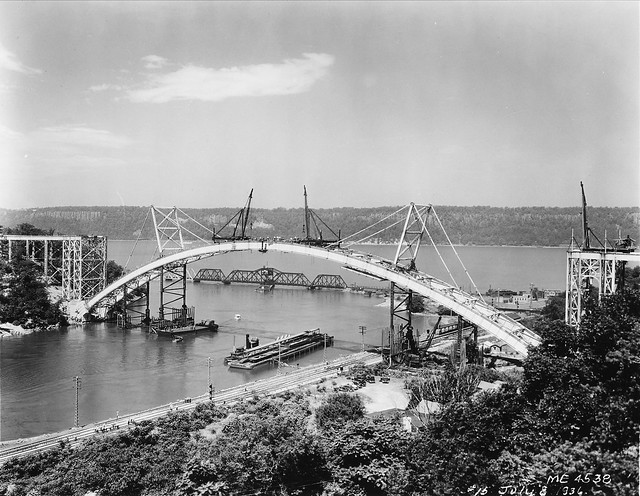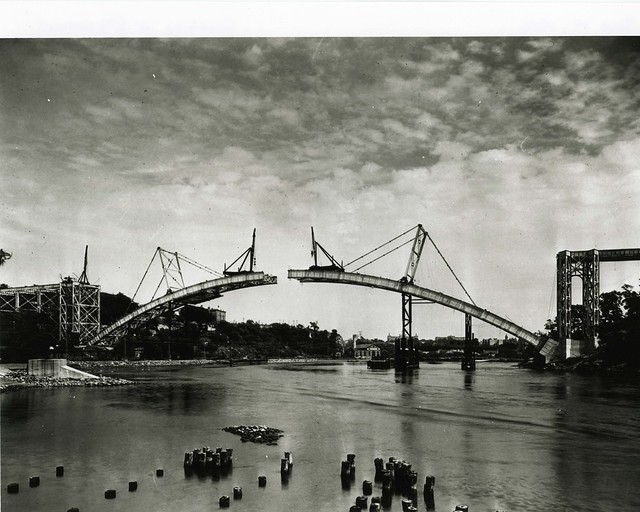
Looking from the Bronx, the final crown piece is placed at the center of the plate-girder, steel arch. New York Central Railroad tracks (now Metro-North) continued operating during construction. The small railroad bridge in the distance belonged to Grand Central Railroad and today is used by Amtrak. Photographer unknown. July 8, 1936.
Throughout elementary and high school, I rode over the Henry Hudson Bridge on a daily basis until I started taking the subway up to the Bronx. The span, seemingly forever under construction, is one of the city’s more minimalist bridges with no sweeping suspension cables or iconic brick work. With a northbound upper level and southbound lower level, it simply does the job, and today, it turns 75.
As part of its birthday celebration, the MTA is opening up its trove of historic photos for the public to see. Beginning today, the Riverdale Public Library will host an exhibit of more than a dozen Depression-era exhibits of the construction of the bridge and the land around it at the time. The 800-foot bridge, which opened in 1936, was the world’s longest plate-girder, fixed arch bridge at the time and was constructed by Robert Moses in an era when driving was a leisure-time activity.
“We are pleased to share some of the thousands of historic photos from our Special Archive in celebration of the Henry Hudson Bridge,” said MTA Bridges and Tunnels President Jim Ferrara. “The Henry Hudson was originally designed for leisurely weekend drives but through the decades has evolved into a vital transportation connection in the tri-state region, linking New York City and the northern suburbs.”
At the time, Moses faced opposition to the bridge mostly from those underwriters who believed motorists would not pay a 10-cent crossing fee with the free Broadway bridge mere blocks away, but the master planner knew that the views of the Palisades would make it a popular crossing for weekend drivers. The lower level opened 18 months later in 1938, and the price tag for the entire bridge was just $5 million.
Today, around 63,000 cars per day cross the Henry Hudson Bridge, and the MTA is amidst a $33 million rehab project that will see the original steel curb stringers that brace the upper level replaced. The MTA last year wrapped an $86 million rehab that saw the lower level completely replaced and the pedestrian walkway refurbished. “All of this work is being done to make sure that the bridge remains as strong as it was the day it opened and for many decades to come,” Facility Engineer Walter Hickey said in a statement.
After the jump, another glimpse at the Henry Hudson Bridge under construction.

The Henry Hudson Bridge under construction. Photographer: Richard Averill Smith, June 19, 1936.

10 comments
That top photo must have been incorrectly loaded. There is only a tiny square with an “x” inside.
A few minutes later, the photo is now visible.
The Republican policies of the 1920s that caused the first Great Depression fought FDR tooth and nail on every economic remedy to create jobs BUT Congress had enough elected Democrats to get things done despite a lot of very nasty fighting.
Until Americans decide having a President and Congress of different philosophies only causes gridlock and right now, we really don’t need that.
Thank God FDR got all those amazing projects built since there won’t be any new ones anytime soon.
Republicans have no right to call themselves Christians.
Amen to that.
Those Republicans are wily. Even when they have no power they disrupt all yopu great plans. Kind of like the way the Kulaks and “counter revolutionary elements” were always messing up the Soviet grain harvest.
The bridge is unique in the metro area because it’s more like those mountain gorge bridges you see in the more mountainous areas. But like most of Moses’ pre-World War II efforts, it connects to a highway that’s better suited for Sunday drives in the country than it is for daily commutes.
From a transit prospective, the impending change-over to toll-by-photo on the Henry Hudson Bridge will be a major test to see if a similar system would work on the East River bridges. Camera capture of license plates to send toll charges to for non-EZ Pass users is the only way tolling the East River spans will work, since there’s no feasible way to put booths at one end of the Brooklyn, Manhattan Willie B and Queensboro spans.
Eliminating the free crossing option would both give the city and/or the MTA an additional fund stream while at the same time giving drivers more motivation to switch over to mass transit or commuter rail. But we will have to see what the toll collection rate is on the bills sent out, since system won’t work unless the fear of action for non-observance of the law is there.
That the Henry Hudson Bridge is needed as a “test” for this system is so typically MTA. Open road tolling is a proven technology already in use elsewhere. Texas and Ontario have been using it for several years now. Maryland and Quebec have also started using it within the past year, and North Carolina will be bringing it online on their first modern toll road come January.
Forget “let’s see whether it can work”. It can work.
The Illinois Tollway has had high speed open tolling since 2004 or 2005 (iPass/EzPass plus photos). Why the MTA needs to run a test run is a good question.
The Power Broker details the history of this bridge and the West Side Highway construction, and how Moses managed to scrimp, borrow and steal funding for this bridge to get it completed, in addition to engineering a bridge with just two steel arches instead of the traditional three.
Makes me wonder how the rebuilding effort of the Tappan-Zee and Kosciuszko are going to fare.
The caption is slightly incorrect. The rail bridge belonged to the New York Central Railroad not the “Grand Central Railroad”.